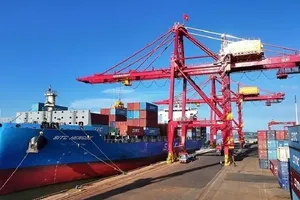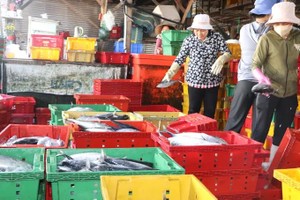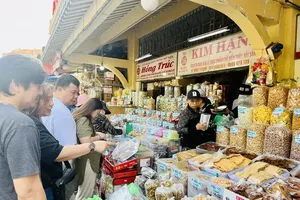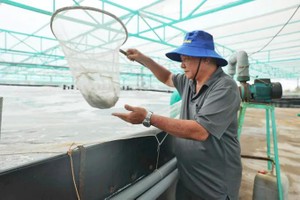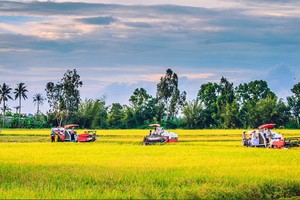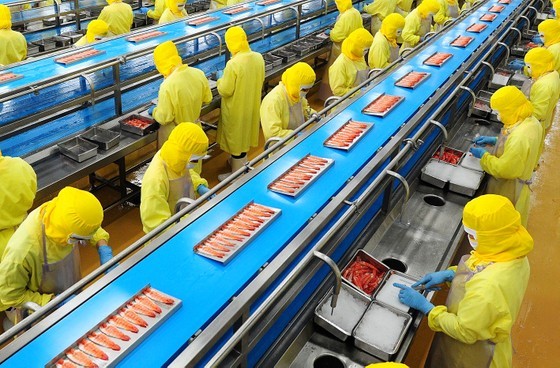 |
Shrimp processing at a company in Thua Thien - Hue. |
Nonetheless, the shrimp industry is encountering difficulties attributed to fierce competition from other nations.
Many disadvantages
According to Mr. Ngo The Anh, Director of the Aquaculture Department of the Vietnam Directorate of Fisheries under the MARD, Vietnamese shrimp exports hold the second global position, accounting for 13-14 percent of the total export value of the global shrimp industry. On average, shrimp contributes approximately 45 percent to the annual total seafood export value, equivalent to around US$3.5-4 billion.
Despite an expansion in the shrimp farming area during the initial six months of the year (exceeding 650,000 hectares, up 6.4 percent compared to the same period), and a successful harvest (467,000 tons, up 4 percent compared to the same period), the shrimp export turnover has dwindled as input costs and production expenses elevated, while the selling prices was relatively low.
Consequently, shrimp exports have experienced a nearly 32 percent decline in comparison to the same period last year, with the most significant decreases witnessed in the EU market at 48 percent, the US at 38 percent, South Korea at 28 percent, Japan at 29 percent, and China at 15 percent.
Amidst the drop in exports, shrimp-exporting enterprises have highlighted the array of challenges currently confronting the shrimp industry, with a specific focus on technical barriers.
Mr. Le Van Quang, CEO of Minh Phu Seafood Corporation in Ca Mau Province, revealed that his company has been creating raw material growing zones tailored to meet the demands of distinct markets like the US and the EU, yet the areas with official certifications remain limited. While Vietnam is actively implementing various GlobalGAP certifications, it is noteworthy that these certifications are not obligatory in major markets. Meanwhile, businesses in Ecuador have benefited from substantial government assistance in obtaining certifications for their aquaculture areas.
"Localities, ministries, and departments should collaborate with organizations and businesses to verify and certify raw material zones in line with market demands. In other words, we should adhere to the standards the market requires rather than those they don't," advised Mr. Le Van Quang.
On the other hand, some markets remain skeptical and subject imported shrimp shipments to 100 percent antibiotic residue testing, with the Japanese market being a particular example. This leads to extra expenses and time for Vietnamese shrimp at the port, diminishing its competitive edge.
Meanwhile, shrimp from Thailand and India imported into Japan are subjected to testing for only 20-30 percent of the shipment. Moreover, in the US market, from 2004 to now, Vietnamese shrimp have encountered disadvantages from trade remedy measures involving anti-dumping investigations and the imposition of anti-dumping duties.
Appropriate adaptation
In her evaluation of overall seafood exports, with a focus on shrimp, Ms. Nguyen Hoang Thuy, Vietnam's Trade Counselor to the Nordic countries, pointed out that the EU is showing a growing preference for seafood while gradually cutting back on red meat consumption to curb carbon emissions from livestock farming.
Concurrently, as part of environmental preservation efforts, EU citizens are increasingly inclined towards eco-friendly and organic shrimp and canned meals. As a result, Vietnamese businesses may explore establishing supply connections for raw shrimp and becoming integral components of the value chain for processing companies.
The Counselor for Agriculture Affairs at the Vietnam Trade Office in the US forecasts a reduction in the inventory of shrimp products in the US by year's end, along with a resurgence in purchasing power among importing enterprises. Furthermore, the nation opts not to raise interest rates as part of its anticipation of gradual inflation control.
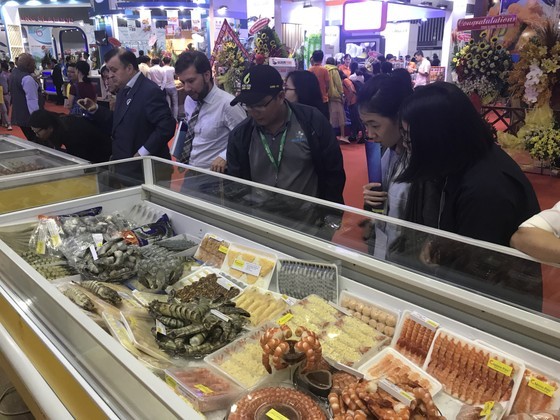 |
Foreign businesses visit the shrimp booth at the Seafood Fair held at the Saigon Exhibition and Convention Center in District 7, Ho Chi Minh City. |
"The US places significant importance on processed shrimp due to its convenience and extended shelf life. On the other hand, Vietnamese businesses should collaborate with global partners to elevate shrimp seed quality. It is crucial to maintain comprehensive records of the production and processing procedures for information traceability and to facilitate on-site inspections conducted by US regulatory authorities," emphasized the Counselor for Agriculture Affairs at the Vietnam Trade Office in the US.
As for the Chinese market, experts underscore that Vietnamese enterprises have just commenced exporting to adjacent border markets while considerable untapped potential remains in the Northern and Central regions of China.
"The ongoing reduction in shrimp farming in China, driven by high input expenses, coupled with the increased import of shrimp from countries with lower production costs for reprocessing and eventual re-export, creates a substantial growth opportunity for the Vietnamese shrimp industry," stated the Trade Counselor of Vietnam in China.
With the goal of surpassing $4.3 billion in shrimp exports in 2023, Mr. Tran Thanh Nam, Deputy Minister of the MARD, has highlighted the shrinking shrimp reserves in different nations. Moreover, countries with rivaling shrimp sectors are reducing production. Seizing this opportunity, Vietnamese businesses should intensify their export endeavors. Furthermore, the Vietnamese trade offices should reassess whether elevated logistics expenses or raw material costs play a pivotal role and liaise with the MARD to foster collaboration with relevant units.
"The ministry's perspective is against compromising shrimp quality by sourcing inexpensive raw materials. As for sustainable, long-term development strategies, Vietnamese trade offices should intensify efforts to promote and showcase Vietnam's shrimp image and promptly furnish market fluctuation insights to the MARD and the Ministry of Industry and Trade (MoIT) to steer farming areas, processing operations, and exports. Furthermore, the MoIT should bolster the signing of free trade agreements, assist enterprises in harnessing the potential of these agreements, and formulate adaptable approaches to address technical barriers," highlighted Deputy Minister Tran Thanh Nam.
In 2022, shrimp exports attained a value of $4.3 billion. The leading trio of provinces in the nation for shrimp exports included Ca Mau (over $1 billion), Soc Trang (nearly $1 billion), and Bac Lieu (over $850 million). In the first half of 2023, Ca Mau Province exported more than $497 million worth of shrimp; Soc Trang was poised to achieve $420 million; and Bac Lieu raked $413 million. In terms of shrimp export destinations in the first half of 2023, the EU contributed $192 million; the US, $298 million; South Korea, $166 million; Japan, $236 million; and China, $280 million.
